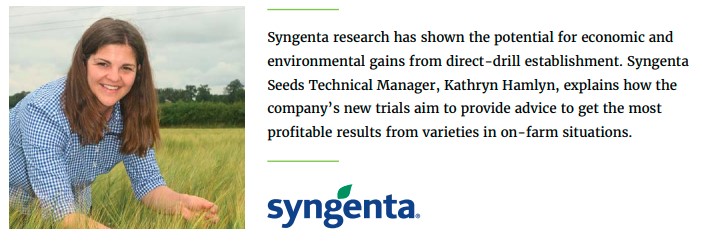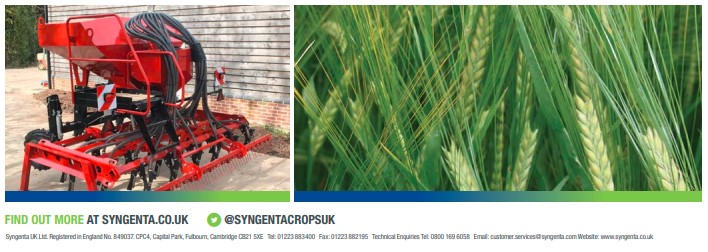
A new approach to crop trials will provide an essential insight into how seed varieties perform under different establishment systems, enabling better advice aimed at maximising performance in the field, including specifically for direct-drill systems.
While the Recommended List (RL) trials have historically been designed to accurately reflect the genetic potential of a variety, and do give growers crucial comparative data, they are typically undertaken with specialist small-plot equipment, under intensive conventional tillage, in ideal conditions and managed to the nth degree to exploit the best from the seeds.
Now, at Syngenta we have instigated an exciting new trials programme to run in parallel, aimed at bridging the gap between the small plot trials and different farm practices – to bring a better understanding of how products and varieties perform. The trials will better reflect real farm scenarios, to aid more appropriate agronomic choices, as well as integrating other pressures and influences that impact on growers’ decision-making process.
Key to the move has been investment in a pioneering new trials drill and equipment, purpose designed to enable establishment in a range of systems, from conventional tillage right through to direct drilling into stubble or cover crops. It also facilitates trials to investigate how wider agronomy aspects, such as drilling date, seed rate, drill coulter width and cultivation methods, influence how varieties will perform.
The bespoke new drill has been made to Syngenta specifications by Huffle Engineering. The coulters on the drill can be swapped between tines and discs, depending on the drilling scenario required. The row spacings at 12.5 cm allows trials at 12.5, 25, 37.5 and 50 cm crop row widths – to compare results and enable alternative practices, such as mechanical hoeing. The dual hopper on the drill also facilitates trials looking at fertiliser applications at drilling, for example, or companion crops, such as wheat and beans at different seed ratios.
Seed trialist, Rory Hannam, explained that this unique drill has been specially designed to be more flexible than other conventional trials drills. “It’s a step forward for Syngenta and opens up a whole range of possibilities with the trials work that can now be done,” he added.
The seed trials’ development builds on our five-year Conservation Agriculture and Sustainable Farming Initiative, comparing crop performance, financial results and environmental implications of crop establishment using three different systems – conventional plough-based; non-plough tillage and a direct-drill.
Independently monitored and evaluated research, involving over 10,000 measured data points, covers a full-farm rotation on a heavy land site in Leicestershire and a light land farm, at Lenham in Kent. It has shown that while establishment can be more challenging under a direct-drill system and yields might be reduced, particularly in the early years of transition from conventional systems, overall the net farm profitability can be up to 36% higher on light soils (19% on heavy land), and the environmental gains hugely enhanced.
The research has proven the potential for direct-drill conservation agriculture techniques to significantly cut greenhouse gas emissions, by around 16%, and reduce the carbon footprint of crop establishment on both heavy and light land farms by nearly 10%. Earthworm numbers on the light land soil have been boosted by up to 75% under the direct-drill regime.
However, we found that over the course of the trial across the two farms, establishment has been lower with the direct-drill or light-till establishment, down by around 3% on lights land and 9% on heavy land. Overall average yields have been down by an average of 7% on the heavy land, but up 3% on light land soils.
With the potential economic and environmental gains seen from direct drill establishment, the emphasis of the new Syngenta seeds variety trials’ is now looking to overcome that yield gap with appropriate agronomy responses, to get the best performance from varieties.
In the first season’s trials, for example, results confirmed the challenges of spring barley establishment under a direct-drill system on the company’s heavy clay-loam trial site in Cambridgeshire, into soils that had previously been conventionally ploughed and tilled. Across three different seed rates, of 350, 420 and 525 seeds per m2, establishment was 30% lower with the direct-drill system, compared to minimal tillage or plough-based conventional tillage.

Furthermore, tillering was greater in the plough-based system, compared to both min-till and direct drill. Compounded by weather conditions after drilling with the lowest April temperatures and rainfall for 30 years, followed by low temperatures and wet conditions in May, this was reflected in the yields where the plough-based establishment was highest. This also showed the increase in seed rate did give a large rise in yield with the direct-drill establishment.
Increasing spring barley seed rates did also have an effect on increasing yield in each system, however this was minimal in both the plough and min-till systems and did not cover the extra seed cost. The variety selected for the trial was the dual-purpose spring malting barley, SY TUNGSTEN, with potential for both the brewing and malt distilling markets. It has Provisional MBC approval and is undergoing its final year of testing in 2022, with the important attraction of performing well for growers across England and Scotland.
We plan to repeat the trial in 2022, along with similar trials for winter wheat and winter barley, with an increasing range of varieties. A long-term research project will also look to see how multiple years of the same establishment system, including direct drilling, impacts on variety performance.
The information we have gathered from these trials will prove essential in helping growers select the most appropriate varieties and agronomic inputs to get the best results from their specific on-farm establishment systems and individual situations. Building a greater knowledge bank of varietal responses to cultivations, in-season agronomy and weather conditions will be essential for farmers’ more effective decision making in the future.